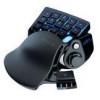Belkin n52te User Manual - Page 4
Repeat Until Next Key - macro
 |
UPC - 722868643150
View all Belkin n52te manuals
Add to My Manuals
Save this manual to your list of manuals |
Page 4 highlights
Repeat Mode - This setting determines how the macro will be played back when triggered: • Run Once (Default Setting) - Using this setting executes the macro only once each time the assigned n52te button is pressed. • Repeat while pressed - Using this setting will force the macro to repeat continuously while the assigned n52te button is held down. • Repeat Until Next Key - Using this setting forces the assigned button to act like a toggle switch. If you push it once and let go, the macro will continuously repeat until the same button is pressed again. Delay - This sets the delay between every event item in a macro sequence to the same value. DEVICE The "Device" pane provides information on the connectivity status of the n52te, the firmware revision, and the version of the n52te Editor software, and allows you to set the polling frequency. CREATING A MACRO This section will explain how to create a macro using the n52te Editor software. 1. Click the "New" button to create a new macro. 2. To give it a name, type it into the "Macro Name" field under the "Available Macros" list. 3. To define a different repeat behavior, select it from the "Repeat Mode" drop-down menu. Note: The default repeat behavior is "Repeat Once". 4. Click on the "Record" button to start recording keyboard events. 5. Using the keyboard, type in the keystroke combination of the macro you want to create. This will normally be linking spells to create a new combo, or phrases, such as "cover me," that you would send to your teammates. Notice the keys you press and release are recorded in the "Macro Definition" list. 6. You can give the new macro a name by typing it into the "Macro Name" field under the "Available Macros" list. 7. If you wish to manually insert keystrokes or mouse buttons, you can do so with the "Add Button" function. 8. If you wish to manually set delays between each key press, you can do so with the "Insert Delay" button. 9. If you wish to manually remove items in the macro sequence, you can do so with the "Remove" button. 10. If you are finished editing your macro, go back to the "Profiles" pane and your new macro will automatically be saved. 11. Your newly created macro is now assigned to the n52te button you have chosen. Firmware Version - This displays the firmware version of the n52te currently connected to your Mac computer. Software Version - This displays the version of the n52te Editor software currently installed. Polling Frequency - Sets the polling rate to: 125Hz, 500Hz, or 1000Hz. Connectivity - This graphical display shows whether the n52te is currently connected. Page 4









